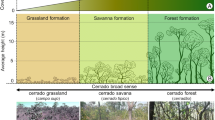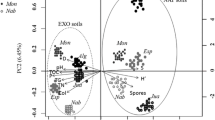Abstract
Savanna vegetation in the northern region of Brazil is jeopardized by several anthropogenic activities including cattle ranching and extensive agriculture, and soil biota of these ecosystems is virtually unknown. The soils in savannas are poor in nutrients, very acidic, and subject to drought, and under these conditions, arbuscular mycorrhizal fungi (AMF) are likely to play a key role on plant nutrition and improving soil structure. In this study, we surveyed AMF communities in five savanna locations in Roraima state, Northern Brazil. AMF species were identified using two approaches: field collected spores and trap cultures. Twenty-three AMF species were identified, including 21 species in field samples, 8 species in trap cultures, of which 15 and 2 were unique to field and trap culture samples, respectively. Gigaspora margarita, Dentiscutata heterogama, and Glomus sp1 were the most frequent species recovered from all locations. AMF communities were dominated by members of Gigasporaceae that accounted for 50 to 87% of the total species richness within each location. Spore numbers differed across locations and ranged from 5 to 25 spores 100 cm−3 soil. Redundancy analysis indicated that soil organic matter was the only selected predictor among soil parameters and correlated positively with occurrence of Glomus heterosporum. We conclude that savannas in Roraima harbor a high sporulating AMF species richness with communities dominated by members of Gigasporaceae and that organic carbon is an important edaphic factor influencing AMF community composition in this ecosystem.


Similar content being viewed by others
References
Alexander M (1965) Most-probable-number method for microbial populations. In: Black CA (ed) Methods in soil analysis. American Society of Agronomy, Madison, Wisconsin, pp 1467–1472
Alguacil MM, Lozano Z, Campoy MJ, Roldán A (2010) Phosporus fertilisation management modifies the biodiversity of AM fungi in a tropical savanna forage system. Soil Biol Biochem 42:1114–1122
Augé RM (2001) Water relations, drought and vesicular-arbuscular mycorrhizal symbiosis. Mycorrhiza 11:3–42
Assis CR, Saggin Júnior O, Paulino HB, Stürmer SL, Siqueira JO, Carneiro MAC (2014) Fungos micorrízicos arbusculares em campos de murundus após a conversão para sistemas agrícolas no Cerrado. Revista Brasileira de Ciência do Solo 38:1703–1711
Barbosa RI, Campo C, Pinto F, Fearnside PM (2007) The “Lavrados” of Roraima: biodiversity and conservation of Brazil’s amazonian savannas. Funct Ecosyst Comm 1:29–41
Barbosa RI, Bacelar-Lima CG (2008) Notas sobre a diversidade de plantas e fitofisionomias em Roraima através do banco de dados do Herbário INPA. Amazônia: Ciência and Desenvolvimento 4:131–154
Blanchet G, Legendere P, Borcard D (2008) Forward selection of spatial explanatory variables. Ecology 89:2623–2632. https://doi.org/10.1890/07-0986.1
Blaszkowski J (2012) Glomeromycota. W. Szafer Institute of Botany, Polish Academy of Sciences, Kraków
Bononi VLR, Trufem SFB (1983) Endomicorrizas vesiculo-arbusculares do cerrado da Reserva Biológica de Moji-Guaçu, SP, Brasil. Rickia 10:55–84
Brown JH, Lomolino MV (2008) Biogeography. Sinauer Associates, Inc Publishers, Massachusetts
Brundrett MC, Ashwath N (2013) Glomeromycotan mycorrhizal fungi from tropical Australia III. Measuring diversity in natural and disturbed habitats. Plant Soil 370:419–433
Carneiro-Filho A (1990) “Roraima Savannas”: climax situation or botanic relic. In: Prost MT (Org) Évolution des Littoraux de Guyane et de la Zone Caraibe Méridionale Pendant le Quaternarie. Cayenne, Guiane. pp. 31–48
Carvalho F, de Souza FA, Carrenho R, Moreira FMS, Jesus EC, Fernandes GW (2012) The mosaic of habitats in the high-altitude Brazilian rupestrian fields is a hotspot for arbuscular mycorrhizal fungi. Appl Soil Ecol 52:9–19
Costa NL, Moraes A, Oliveira RA, Gianluppi V, Bendahan AB, Magalhães JA (2011) Rendimento potencial de pastagens de Trachypogon plumosus nos cerrados de Roraima. Revista Agro@mbiente 5:200–206
Cotton TEA, Fitter AH, Miller RM, Dumbrell AJ, Helgason T (2015) Fungi in the future: interannual variation and effects of atmospheric change on arbuscular mycorrhizal fungal communities. New Phytol 205:1598–1607
Cuenca G, Lovera M (1992) Vesicular-arbuscular mycorrhizae in disturbed and revegetated sites from La Gran Sabana, Venezuela. Can J Bot 70:73–79
Cuenca G, Andrade Z, Escalante G (1998) Diversity of glomalean spores from natural, disturbed and revegetated communities growing on nutrient-poor tropical soils. Soil Biol Biochem 30:711–719
Dray S, Legendre P, Blanchet G (2016) Packfor: forward selection with permutation. R package version 0.0-8/r136. https://R-Forge.R-project.org/projects/sedar/
Gauch HG (1982) Multivariate analysis in community ecology. Cambridge University Press, Cambridge
Gerdemann JW, Nicolson TH (1963) Spores of mycorrhizal Endogone species extracted from soil by wet sieving and decanting. Trans British Mycol Soc 84:679–684
Gianinazzi S, Gollotte A, Binet M-N, van Tuinen D, Redecker D, Wipf D (2010) Agroecology: the key role of arbuscular mycorrhizas in ecosystem services. Mycorrhiza 20:519–530
Hammer Ø, Harper DAT, Rya PD (2001) PAST: paleontological statistics software package for education and data analysis. Palaeontol Electron 4(1):9pp http://palaeo-electronica.org/2001_1/past/issue1_01.htm
Hart MM, Reader RJ (2002) Taxonomic basis for variation in the colonization strategy of arbuscular mycorrhizal fungi. New Phytol 153:335–344
Hernández-Hernández RM, Roldán A, Caravaca F, Rodriguez-Caballero G, Torres MP, Maestre FT, Alguacil MM (2017) Arbuscular mycorrhizal fungal assemblages in biological crusts from a Neotropical savanna are not related to the dominant perennial Trachypogon. Sci Total Environ 575:1203–1210
Hill MO, Gauch HG Jr (1980) Detrended correspondence analysis: an improved ordination technique. Vegetatio 42:47–58
House GL, Ekanayake S, Ruan Y, Schütte UME, Kaonongbua W, Fox G, Ye Y, Bever JD (2016) Phylogenetically structured differences in rRNA gene sequence variation among species of arbuscular mycorrhizal fungi and their implications for sequence clustering. Appl Environ Microbiol 82:4921–4930
Huber O (1987) Neotropical savannas: their flora and vegetation. TREE 2:67–70
Jobim K, Oliveira BIS, Goto BT (2016) Checklist of the glomeromycota in Brazilian savanna. Mycotaxon (in press)
Johnson NC, Zak DR, Tilman D, Pfleger FL (1991) Dynamics of vesicular-arbuscular mycorrhizae during old field succession. Oecologia 86:349–358
Koske RE, Gemma JN (1989) A modified procedure for staining roots to detect VA mycorrhizas. Mycol Res 92:488–505
Lee PJ, Koske RE (1994) Gigaspora gigantea – parasitism of spores by fungi and actinomycetes. Mycol Res 98:458–466
Lekberg Y, Koide RT, Rohr JR, Aldrich-Wolfe L, Morton KB (2007) Role of niche restrictions and dispersal in the composition or arbuscular mycorrhizal fungal communities. J Ecol 95:95–105
Lovera M, Cuenca G (1996) Arbuscular mycorrhizal infection in Cyperaceae and Gramineae from natural, disturbed and restored savannas in La Gran Sabana, Venezuela. Mycorrhiza 6:111–118
Lovera M, Cuenca G (2007) Diversidad de hongos micorrizicos arbusculaes (HMA) y potencial micorrízico del suelo de una sabana natural y unasabana perturbada de La Gran Sabana, Venezuela. Interciencia 32:108–114
Meneses MENS, Costa ML (2012) Caracterização mineralógica e química dos regolitos de uma área de transição savana-floresta em Roraima: uma análise da evolução da paisagem. Revista Brasileira de Geociências 42:42–56
Molina R, Horton TR, Trappe JM, Marcot BG (2011) Addressing uncertainty: how to conserve and manage rare or little-known fungi. Fungal Ecol 4:134–146
Muchane MN, Muchane M, Mugoya C, Masiga CW (2012) Effect of land use system on arbuscular mycorrhiza fungi in Maasai Mara ecosystem, Kenya. Afr J Microbiol Res 6:3904–3916
Oehl F, Sieverding E, Ineichen K, Mäder P, Wiemken A, Boller T (2009) Distinct sporulation dynamics of arbuscular mycorrhizal fungal communities from diferente agroecosystems in long-term microcosms. Agric Ecosyst Environ 134:257–268
Oksanen J, Blanchet GF, Kindt R, Legendre P, Minchin PR, O’Hara RB, Simpson GL, Solymos P, Stevens MHH, Wagner H (2015) Vegan: Community Ecology Package. R package version 2. 3–0. http://CRAN.R-project.org/package=vegan
Olson DM, Dinerstein E, Wikramanayake ED, Burgess ND, Powell GVN, Underwood EC, D’Amico JA, Itoua I, Strand HE, Morrison JC, Loucks CJ, Allnutt TF, Ricketts TH, Kura Y, Lamoreux JF, Wettengel WW, Hedao P, Kassem KR (2001) Terrestrial ecoregions of the world: a new map of life on earth. Bioscience 51:933–938
Öpik M, Moora M, Liira J, Zobel M (2006) Composition of root-colonizing arbuscular mycorrhizal fungal communities in different ecosystems around the globe. J Ecol 94:778–790
R Core Team (2015) R: a Language and Environment for Statistical Computing. R Foundation for Statistical Computing, Vienna, Austria http://www.R-project.org/
Ramos-Zapata JA, Zapata-Trujillo R, Ortíz-Diaz JJ, Guadarrama P (2011) Arbuscular mycorrhizas in a tropical coastal dune system in Yucatan, Mexico. Fungal Ecol 4:256–261
Redecker D, Schüssler A, Stockinger H, Stürmer SL, Morton JB, Walker C (2013) An evidence-based consensus for the classification of arbuscular mycorrhizal fungi (Glomeromycota). Mycorrhiza 23:515–531
Rodríguez-Echeverría S, Teixeira H, Correia M, Timóteo S, Heleno R, Öpik M, Moora M (2017) Arbuscular mycorrhizal fungi communities from tropical Africa reveal strong ecological structure. New Phytol 213:380–390
SAS Institute (1995) JMP statistics and graphics guide. SAS Institute Inc., Cary, NC, USA
Siqueira JO, Colozzi-Filho A, Oliveira E (1989) Ocorrência de micorrizas vesicular-arbusculares em agro e ecossistemas do estado de Minas Gerais. Pesq Agrop Brasileira 24:1499–1506
Silva IR, Mello CMA, Neto RAF, Silva DKA, Melo AL, Oehl F, Maia LC (2014) Diversity of arbuscular mycorrhizal fungi along an environmental gradient in the Brazilian semiarid. Appl Soil Ecol 84:166–175
Smith SE, Read DJ (2008) Mycorrhizal symbiosis. Academic Press, London
Souza RG, Maia LC, Sales MF, Trufem SFB (2003) Diversity and infectivity potencial of arbuscular mycorrhizal fungi in area of Caatinga in the Xingó, Region, State of Alagoas. Braz J Botany 26:49–60
Stürmer SL, Stürmer R, Pasqualini D (2013) Taxonomic diversity and community structure of arbuscular mycorrhizal fungi (Phylum Glomeromycota) in three maritime sand dunes in Santa Catarina state, South Brazil. Fungal Ecol 6:27–36
Stutz JC, Morton JB (1996) Successive pot cultures reveal high species richness of arbuscular endomycorrhizal fungi in arid ecosystems. Can J Bot 74:1883–1996
Tchabi A, Coyne D, Hountondji F, Lawouin L, Wiemken A, Oehl F (2008) Arbuscular mycorrhizal fungal communities in sub-Saharan savannas of Benin, West Africa, as affected by agricultural land use intensity and ecological zone. Mycorrhiza 18:181–195
Tedesco MJ, Gianello C, Bissani CA, Bohnen H, Volkweiss SJ (1995) Análise de solo, plantas e outros materiais. Boletim Técnico No 5. UFRGS, Porto Alegre
Turrini A, Giovannetti M (2012) Arbuscular mycorrhizal fungi in national parks, nature reserves and protected areas worlwide: a strategic perspective for their in situ conservation. Mycorrhiza 22:81–97
Acknowledgements
We would like to thank Andressa Franzoi Sgrott for technical assistance and Chaiane Schoen and Alexandre Uhlmann for helping with the statistical analyses. SLS thanks the CNPq for a Research Assistantship (Process 302343/2012-1).
Funding
This study was funded by the Conselho Nacional de Desenvolvimento Científico e Tecnológico (CNPq, Grant No. 483.657/2011-5).
Author information
Authors and Affiliations
Corresponding author
Additional information
Section Editor: Dominik Begerow
Rights and permissions
About this article
Cite this article
Stürmer, S.L., Kemmelmeier, K., Moreira, B.C. et al. Arbuscular mycorrhizal fungi (Glomeromycota) communities in tropical savannas of Roraima, Brazil. Mycol Progress 17, 1149–1159 (2018). https://doi.org/10.1007/s11557-018-1430-5
Received:
Revised:
Accepted:
Published:
Issue Date:
DOI: https://doi.org/10.1007/s11557-018-1430-5




